Your cart is currently empty!
Arum Lily (Zantedeschia aethiopica): An Elegant and Versatile Garden Gem

Introduction
The arum lily, scientifically known as Zantedeschia aethiopica, is a captivating perennial plant that adds grace and elegance to any garden. Native to South Africa, this versatile beauty has gained immense popularity worldwide due to its striking appearance and ease of cultivation.
Botanical Description
Morphology
Arum lilies possess sturdy, fleshy rhizomes that give rise to erect stems. The foliage consists of large, arrow-shaped leaves with smooth edges and prominent veins. The leaves can vary in size and shape depending on the cultivar.
The most distinctive feature of the arum lily is its unique flower, known as a spadix. The spadix is a central spike surrounded by a large, showy bract called a spathe. The spathe gives the flower its trumpet-like shape and comes in a range of colors, including white, yellow, pink, and purple.
Toxicity
It is important to note that all parts of the arum lily are toxic to humans and animals when ingested. The plant contains calcium oxalate crystals that can cause irritation and swelling of the mouth and throat.
Cultivation and Care
Hardiness
Arum lilies are hardy in USDA hardiness zones 8-11. In colder climates, they can be grown in pots and brought indoors during the winter.
Sun and Soil Requirements
These plants prefer full sun to partial shade and well-drained, fertile soil rich in organic matter.
Watering
Water arum lilies regularly, especially during the growing season. Allow the soil to dry out slightly between waterings.
Fertilization
Fertilize arum lilies monthly during the growing season with a balanced, water-soluble fertilizer.
Propagation
Arum lilies can be propagated by dividing the rhizomes in spring or fall. Simply dig up the rhizomes, divide them into smaller sections, and replant them in the garden.
Varieties and Uses
Varieties
There are numerous cultivars of arum lilies available, each offering unique characteristics. Some popular varieties include:
- ‘White Giant’: A classic variety with pure white spathes and tall stems.
- ‘Sunrise’: A compact cultivar with apricot-colored spathes.
- ‘Black Magic’: A dramatic variety with deep purple spathes.
Uses
Arum lilies are versatile plants that can be used in a variety of garden settings:
- Borders and beds: Arum lilies create a striking backdrop or focal point in borders and flower beds.
- Containers: Arum lilies can be grown in pots or containers for patios, balconies, and indoor spaces.
- Cut flowers: The long-lasting flowers of arum lilies make them excellent cut flowers for bouquets and arrangements.
Common Pests and Diseases
Pests
- Aphids: Small, soft-bodied insects that feed on plant sap.
- Spider mites: Tiny, spider-like creatures that can cause foliage damage.
Diseases
- Bacterial soft rot: A bacterial infection that causes the rhizomes to rot and collapse.
- Leaf spot: A fungal disease that causes brown or black spots on the leaves.
Tips for Success
- Plant arum lilies in well-drained soil to prevent root rot.
- Provide regular watering, but avoid overwatering.
- Fertilize arum lilies monthly during the growing season.
- Divide and replant arum lilies every 3-4 years to maintain vigor.
- Protect arum lilies from frost in colder climates by mulching or bringing them indoors.
Conclusion
The arum lily is a captivating and rewarding plant that adds elegance and grace to any garden. With its striking flowers, versatile uses, and relatively easy care requirements, it is a must-have for plant enthusiasts of all levels. By following the tips outlined in this guide, you can enjoy the beauty of arum lilies season after season.








Leave a Reply